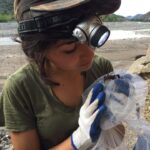
Nathaly Nicole Camargo Quiroga
San Francisco Xavier University of Chuquisaca
Sucre, Bolivia
Luis Adam Briancon Experimental Biology Institute
Associate Researcher
nathalynicolecamargo[at]gmail.com
I am an associate researcher at the Luis Adam Briancon Experimental Biology Institute at the San Francisco Xavier University of Chuquisaca. I recently returned to Latin America after completing an international master’s degree in Biodiversity: Conservation and Education at the University of Valencia, Spain. During my time in Valencia, I focused on the use of molecular biology techniques to investigate the diet of insectivorous bats in the region.
As the first biologist graduated in the city of Sucre, the capital of Bolivia, trained at the San Francisco Xavier University of Chuquisaca, I dedicated my early academic years to the study of diversity and bioacoustic communication in phytophagous insects, specifically focusing on the issue of pests in Chuquisaca’s crops. My interest in bioacoustics and mammals led me to become involved with bats, beginning my journey as a volunteer in the Bat Conservation Program of Bolivia. As I deepened my knowledge of these mammals, my passion and commitment to their study grew, culminating in my appointment as the departmental coordinator of the Bat Conservation Program of Bolivia in Sucre. I conducted various research projects related to the richness and distribution of bats in the Inter-Andean Dry Valleys of Bolivia, along with other projects studying bat activity patterns in green areas of the city of Sucre. Additionally, I conducted studies to assess the social perception of bats among children and young people in Bolivia. My latest research in the ecological field focuses on the structure and composition of bat assemblages in different types of habitats in protected areas of Chuquisaca, Bolivia.
During my training in Europe, as part of the Master’s program, I acquired skills in molecular biology techniques which I later applied to studying the diet of bats in vineyards. In contrast to the traditional methods used in Latin America, based on morphological studies of fecal remains, these new eDNA techniques, such as Illumina Miseq high-throughput sequencing, allowed for the direct identification of prey consumed from guano. In my research, I focused on the fecal samples of insectivorous bats present in vineyards in Enguera and Fontanars dels Alforins (Valencia, Spain), primarily the three species of the Pipistrellus genus. Using Genbank reference data, we managed to identify a wide range of prey, even to the species level. This methodology opens up new opportunities for studying bat diets in Bolivia and represents a great benefit for the conservation of these predators due to their high ecological importance.
Being part of GBatNet team is essential to continue my research work in the field of bats and to implement future conservation projects. In Bolivia, approximately 140 species of bats are known, but there is a shortage of studies on their population status and the roles they play in ecosystems. With the rapid destruction of forests, it is crucial to conserve biodiversity to maintain ecological balance and promote sustainable development.






